For the 2025 school year, there are 2 public high schools serving 230 students in Harney County SD 3 School District.
Public High Schools in Harney County SD 3 School District have a diversity score of 0.32, which is less than the Oregon public high school average of 0.59.
Public High School in Harney County SD 3 School District have a Graduation Rate of 64%, which is less than the Oregon average of 82%.
The school with highest graduation rate is Burns High School, with 60-69% graduation rate. Read more about public school graduation rate statistics in Oregon or national school graduation rate statistics.
Minority enrollment is 18% of the student body (majority Hispanic), which is less than the Oregon public high school average of 41% (majority Hispanic).
Overview
This School District
This State (OR)
# Schools
4 Schools
371 Schools
# Students
700 Students
204,971 Students
# Teachers
47 Teachers
10,205 Teachers
Student : Teacher Ratio
15:1
15:1
District Rank
Harney County SD 3 School District, which is ranked within the bottom 50% of all 186 school districts in Oregon (based off of combined math and reading proficiency testing data) for the 2021-2022 school year.
The school district's graduation rate of 60-69% has decreased from 85-89% over five school years.
Overall District Rank
#125 out of 189 school districts
(Bottom 50%)
(Bottom 50%)
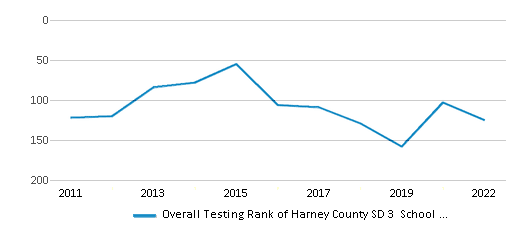
Math Test Scores (% Proficient)
25%
31%

Reading/Language Arts Test Scores (% Proficient)
36%
44%

Science Test Scores (% Proficient)
30-34%
30%
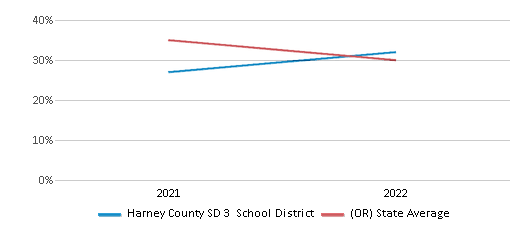
Graduation Rate
60-69%
81%
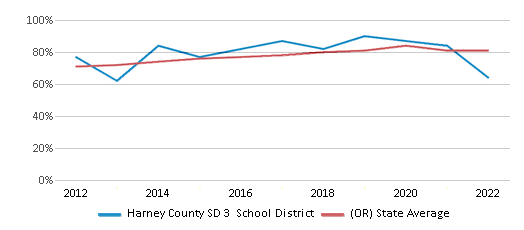
Students by Ethnicity:
Diversity Score
0.36
0.59
# American Indian Students
23 Students
2,693 Students
% American Indian Students
3%
2%
# Asian Students
1 Student
7,961 Students
% Asian Students
n/a
4%
# Hispanic Students
82 Students
51,071 Students
% Hispanic Students
12%
25%
# Black Students
n/a
4,496 Students
% Black Students
n/a
2%
# White Students
552 Students
121,414 Students
% White Students
79%
59%
# Hawaiian Students
n/a
1,535 Students
% Hawaiian Students
n/a
1%
# Two or more races Students
42 Students
13,886 Students
% of Two or more races Students
6%
7%
Students by Grade:
# Students in PK Grade:
-
-
# Students in K Grade:
40
1,709
# Students in 1st Grade:
55
2,008
# Students in 2nd Grade:
45
2,213
# Students in 3rd Grade:
60
2,225
# Students in 4th Grade:
53
2,266
# Students in 5th Grade:
54
2,328
# Students in 6th Grade:
59
3,227
# Students in 7th Grade:
52
4,443
# Students in 8th Grade:
52
4,797
# Students in 9th Grade:
64
44,713
# Students in 10th Grade:
50
46,380
# Students in 11th Grade:
57
44,723
# Students in 12th Grade:
59
43,939
# Ungraded Students:
-
-
District Revenue and Spending
The revenue/student of $18,027 in this school district is less than the state median of $18,279. The school district revenue/student has grown by 6% over four school years.
The school district's spending/student of $17,099 is less than the state median of $19,325. The school district spending/student has grown by 6% over four school years.
Total Revenue
$13 MM
$9,902 MM
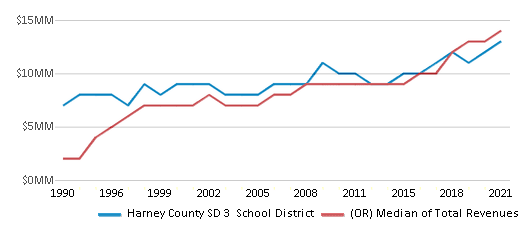
Spending
$12 MM
$10,468 MM
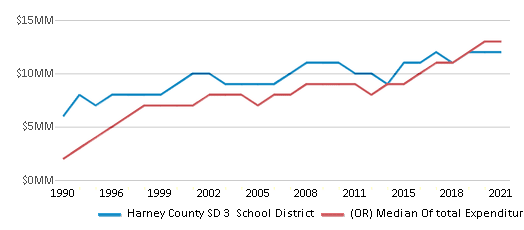
Revenue / Student
$18,027
$18,279
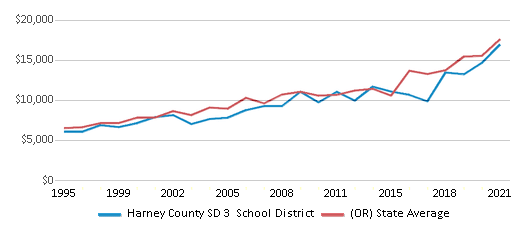
Spending / Student
$17,099
$19,325
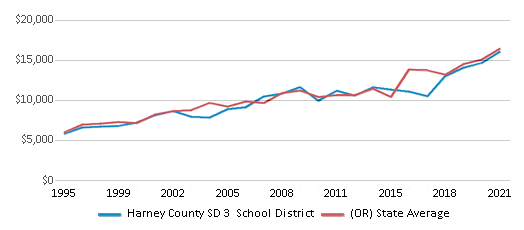
Best Harney County SD 3 School District Public High Schools (2025)
School
(Math and Reading Proficiency)
(Math and Reading Proficiency)
Location
Grades
Students
Rank: #11.
Burns High School
(Math: <50% | Reading: ≥50% )
Rank:
Rank:
8/
Top 30%10
1100 Oregon Ave
Burns, OR 97720
(541) 573-2044
Burns, OR 97720
(541) 573-2044
Grades: 9-12
| 230 students
Rank: #22.
Burns High Desert Academy
Alternative School
(Math: <50% | Reading: <50% )
Rank:
Rank:
6/
Top 50%10
1100 Oregon Ave
Burns, OR 97720
(541) 573-6811
Burns, OR 97720
(541) 573-6811
Grades: K-12
| n/a students
Recent Articles

Year-Round Or Traditional Schedule?
Which is more appropriate for your child? A year-round attendance schedule or traditional schedule? We look at the pros and cons.

Why You Should Encourage Your Child to Join a Sports Team
Participating in team sports has a great many benefits for children, there is no doubt. In this article you will learn what those benefits are.

White Students are Now the Minority in U.S. Public Schools
Increasing birth rates among immigrant families from Asia and Central and South America, combined with lower birth rates among white families, means that for the first time in history, public school students in the United States are majority-minority. This shift in demographics poses difficulties for schools as they work to accommodate children of varying language abilities and socio-economic backgrounds.





